26 Jan 2010
Did you know Dr. Seuss’ Green Eggs and Ham was written on a bet? Neither did I, until I came across a collection of bronze statues of his characters at the Hotel del Coronado in San Diego, California. I snapped this picture of a plaque next to the statue for Green Eggs and Ham.
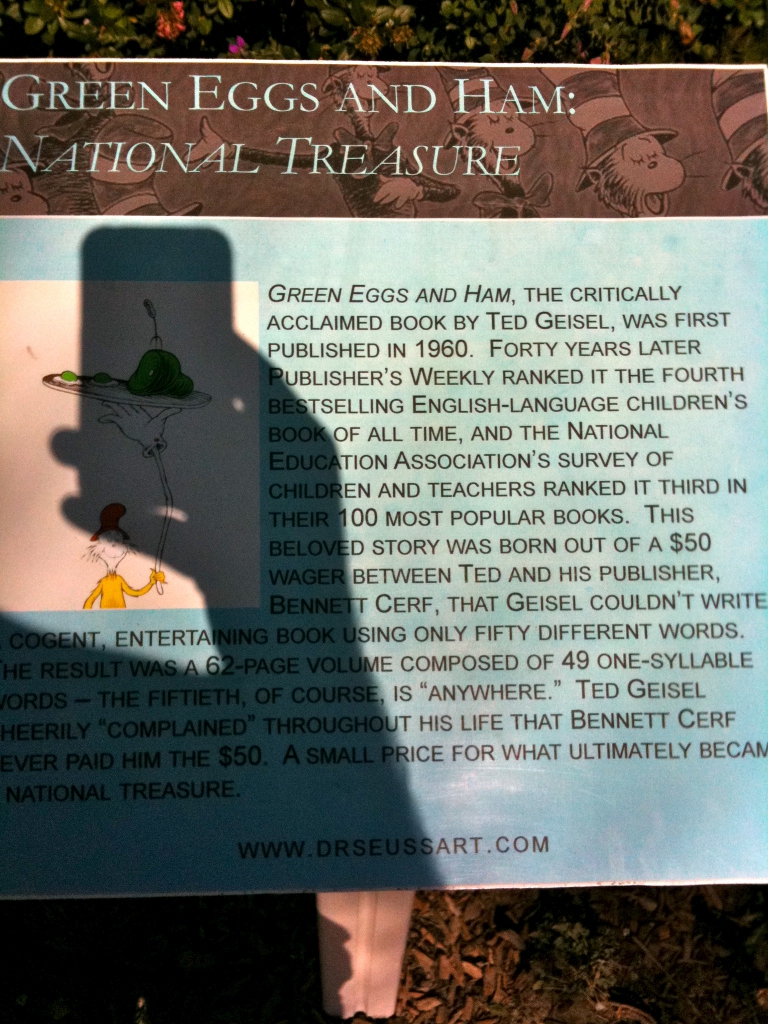
A full tour of all of the statues can be found at http://www.drseussart.com/hotelgallery.html, sadly most of the plaques are not included in the picture tour.
If you can’t read the plaque in the picture, Wikipedia has you covered…
Bennett Cerf, Dr. Seuss’s publisher, wagered $50 that Seuss could not write a book using only fifty different words.[2][3] The bet came after Seuss completed The Cat in the Hat, which used 225 words.
http://en.wikipedia.org/wiki/Green_eggs_and_ham
Dr. Seuss created an American children’s classic on a bet where he was resource limited. Dr. Seuss, in this instance, embodied the mantra of “doing more with less.”
This concept of “doing more with less” isn’t new in the field of computers, and is one of the mantras of 37signals. A quick Google of 37signals more with less kicks up two great articles:
I’ll save you the trouble of a click through: “Less is More” implies that more is better. It’s not. Less is less. Less is just right. Less is better.
I’ve tried this technique of “doing more with less” in how I manage my time and the tasks I would like to accomplish at home. For example, before I would come home from work and have all the time in the world and a long list of things I would like to accomplish. I would keep thinking to myself, “I’ll get to writing that blog post, or playing that new Xbox game, I have hours before I need to be in bed.”
The rub was since I thought I had hours upon hours of time on my hands I would wind up not focusing on any one particular task, get sucked into something on TV, and never accomplish anything.
Every morning I would wake up and ask myself, “Where did all of the time go?”
Thus, in an attempt to live the “less is more” mantra I have restricted the amount of time I allow myself to spend on any one given task at night. I have restricted the amount of time I have to write, program, and play Xbox. By restrict the amount of time I give myself to complete a task I actually spend my time more wisely, accomplishing more than if I just gave myself all of the time in the world.
::Well, I’ve been productive writing and programming, I’m not sure you can call my Xbox time “productive”. However, now I actually finding myself playing my Xbox instead of it collecting dust under my TV. Productive? Microsoft might think so, my wife and dog are not so sure.::
The only thing keeping me from creating the next Green Eggs and Ham is to make a crazy bet with my publisher, which will happen, once I get a publisher.
24 Jan 2010
My name is Benjamin Hysell, and I’m proud to say I’m an artist.
I’m not sure I could have made that statement before reading Seth Godin’s new book Linchpin , but I am now proud to stand up and count myself as one of the many artist in the world.
, but I am now proud to stand up and count myself as one of the many artist in the world.
Background
This past December Seth Godin put out a call on his website, http://sethgodin.typepad.com/seths_blog/2009/12/preview-copy-of-my-new-book.html, offering his readers the opportunity to obtain a review copy of his latest book, Linchpin , at his expense. These books were not review copies that the publisher would have sent free to the press. Seth mailed out the books on his dime to interested readers on one condition; Seth asked everyone who was interested in a book to make at least a $30 donation to the Acumen fund. I went and checked the Acumen fund out and found something I liked:
, at his expense. These books were not review copies that the publisher would have sent free to the press. Seth mailed out the books on his dime to interested readers on one condition; Seth asked everyone who was interested in a book to make at least a $30 donation to the Acumen fund. I went and checked the Acumen fund out and found something I liked:
Acumen Fund is a non-profit global venture fund that uses entrepreneurial approaches to solve the problems of global poverty. We seek to prove that small amounts of philanthropic capital, combined with large doses of business acumen, can build thriving enterprises that serve vast numbers of the poor. Our investments focus on delivering affordable, critical goods and services – like health, water, housing and energy – through innovative, market-oriented approaches.
http://www.acumenfund.org/about-us.html
I signed up, donated, and received my book just a few weeks ago.
::Seth posted on his blog a few days later…he raised over $108,000 for the Acumen Fund through this offer in less than 49 hours. I’m not sure how many books he actually ended up sending out; as he states, some people gave more than $30, but needless to say, a lot of books were sent out into the world and I happen to have one of them.::
I have since read the book twice now, and on the second read through I was having trouble separating my progress bookmark from all of the other pages I bookmarked that I wanted to come back to for this review.
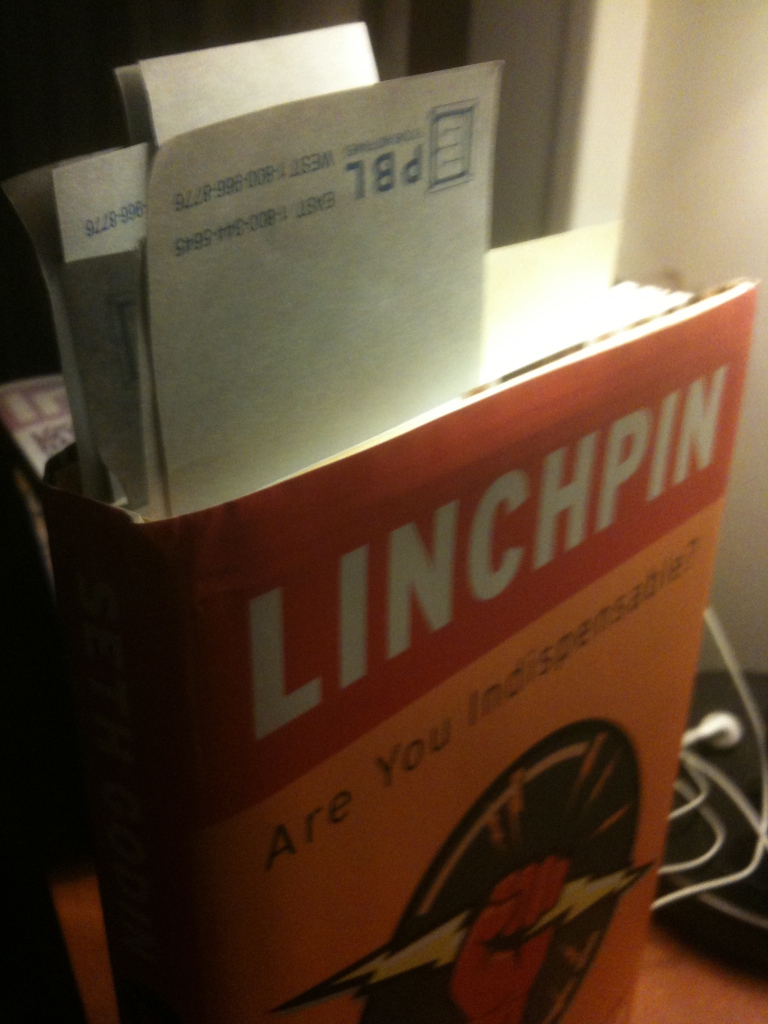
My Verdict
In the vein of many great artists I’m going to tell you how this review ends right at the beginning. The last thing I want you, the reader, to do is to stress out and have to read a couple hundred words to figure out if I liked the book or not.
I enjoy Seth’s blog on a daily basis, his posts are short and to the point, allowing me to digest his daily message quickly over my morning cup of coffee.
Seth’s precision as a writer is his greatest gift, and he has brought this gift to Linchpin by assembling themed chapters out of smaller, self-contained, individual thoughts. These smaller individual thoughts, or “thought-lets”, within the chapters can completely stand on their own, giving one ample opportunity to bookmark them, and come back to them on a regular basis. As you can see in the picture above, I bookmarked quite a few of his thought-lets.
by assembling themed chapters out of smaller, self-contained, individual thoughts. These smaller individual thoughts, or “thought-lets”, within the chapters can completely stand on their own, giving one ample opportunity to bookmark them, and come back to them on a regular basis. As you can see in the picture above, I bookmarked quite a few of his thought-lets.
Reading Linchpin was like consuming a shotgun blast of Seth’s blog posts, printed out, and bound for my reading pleasure.
was like consuming a shotgun blast of Seth’s blog posts, printed out, and bound for my reading pleasure.
The Wakeup Call
We have all seen the manufacturing jobs disappear and move overseas. Seth argues manufacturing jobs were the easiest jobs to move because factory work is easy to describe, manuals can be easily created, and cheaper overseas labor is very easy to train.
Linchpin is a wakeup call to all of us doing white-collar work. We may think our jobs can’t be replaced with cheaper labor, but it is already happening all around us. Call centers are mostly overseas, programming jobs have been going to India, even lawyers are having their jobs shipped overseas. Each one of these jobs have become commoditized, figured out, and moved overseas in the search for cheaper labor, and higher corporate profits.
is a wakeup call to all of us doing white-collar work. We may think our jobs can’t be replaced with cheaper labor, but it is already happening all around us. Call centers are mostly overseas, programming jobs have been going to India, even lawyers are having their jobs shipped overseas. Each one of these jobs have become commoditized, figured out, and moved overseas in the search for cheaper labor, and higher corporate profits.
The trend isn’t likely to stop.
Seth spends considerable time laying the groundwork for Linchpin by telling us how the world is, how we got to where we are, and where the world is likely going. Seth then throws down the gauntlet by challenging us to become indispensable at our jobs by becoming artists.
by telling us how the world is, how we got to where we are, and where the world is likely going. Seth then throws down the gauntlet by challenging us to become indispensable at our jobs by becoming artists.
The Artist Within
Seth argues the common thread between white and blue-collar jobs that have been moved overseas is they are all explainable, they can all be broken down into a “script” anyone could follow to complete the job. Once a map is made on how to do a job, almost anyone can do it.
In Seth’s words, artist don’t follow a map, they create the map.
Artists can’t explain what they do. Sure, artists write books on how to paint, but not what to paint. Artist can’t be replaced, or if they can be replaced, it is very painful to the organization doing the replacing. How can you replace something that you can’t explain, can’t follow, and can’t write a manual to describe what they do?
Seth asks, “What if we all were artists? What if our workplaces were full of artists?”
He passionately argues that we can all be artists, that we have the choice to either follow a map and work ourselves out of a job, or we can choose to become very difficult to replace by becoming invaluable, by being artists.
I’m choosing in this review to focus on Seth’s idea that we should all choose to be artists, I will leave it to the reader to read Seth’s book to understand why we struggle as a species to make it happen.
What Does it Mean to be an Artist?
Several of the common artist themes Seth lays out in Linchpin are:
are:
- Art doesn’t mean you work with paint and canvas, artist create, regardless of medium.
- Artist give gifts.
- Artist produce output.
Paints, Pencils, and Watercolors
Seth argues art doesn’t have to be paint and canvas. Seth points to several examples of famous artists who worked in the conventional “art” mediums and asks aloud what would they be doing today? If the Internet was available to Shakespeare would he have still written his plays? Would Picasso still have painted? Would Shakespeare and Picasso team up for the next great Xbox game?
When asking yourself if you can become an artist, Seth challenges us to not confine ourselves to the classic definition of artist. Seth points out excellent customer service is an art, an amazing chef is an artist, a business owner who can make a million dollars a year is an artist.
I can’t draw for beans, but I can organize a team of freshly minted developers to create a data management system that organizes 50 plus gigabytes of data a month.
I can’t mix primary colors to create just the right shade of orange to paint a sunset, but I know how to architect a bare bones iPhone alarm application.
I can’t play an instrument to save my life, but I write a pretty darn good blog about software, project management, and managing people.
I can’t do anything a classical artist can, but at Seth’s urging I consider myself an artist.
The Act of the Gift
It used to be people who gave the most gifts actually had the most power, not the people receiving the gifts. Seth spends quite a bit of energy convincing us about the power of gifts. He does this by exploring a few lengthy examples of the power of gifts in culture, and the bond the act of gift giving creates between people.
Seth states that giving away your art is a key step in becoming an artist. Speaking up and sharing with the community, providing something without an expectation of compensation, the act of giving a true gift to others can not only enriches those who receive the gift, but giving can feed an inner human need that could never be bought with a paycheck.
I feed my inner desire to gift by writing this blog. I write because I want to change how our industry operates. When I publish an article I am not paid or compensated. My payment is the thought that when others read this blog they think about the topics I choose to write about, and further interact with me in my comments.
“Real Artist Ship!”
Seth uses this famous Steve Jobs quote it to make a point, if you can “create art”, but not publish, you are not an artist.
I have been working on this book review for six hours, I have restarted it four different times, and if I don’t publish it what was all of this effort for? Sure, I might have created something special and unique, but no one would ever know about it if I don’t hit the “publish” button on WordPress.
I can refactor and clean up this posting for the next two days, but if I don’t ship it out the door for the world to enjoy I have not created art. The art only lives once it has left my MacBook Pro, otherwise all I have done is given my fingers a great keyboard workout.
The Choice is Yours and Yours Alone…Good luck.
Seth provides a very compelling argument in Linchpin hopefully causing us to step back, think about what we do on a daily basis, and hopefully decide to change from being cogs in the factory of white-collar work and transition to being artists.
hopefully causing us to step back, think about what we do on a daily basis, and hopefully decide to change from being cogs in the factory of white-collar work and transition to being artists.
Seth states we are all not artist all the time, but it is his hope in this book that we will all be inspired to try to up our artistry in our jobs and in our everyday lives.
24 Nov 2009
Just last night I finished reading Zen and the Art of Motorcycle Maintenance, and decided it was high time to update My Bookshelf with what I’ve been reading lately.
Zen and the Art of Motorcycle Maintenance is not a breezy read, nor, sadly, does it have much to do with motorcycles or Zen. I should have paid more attention to the authors note, which I’ve included here:
What follows is based on actual occurrences. Although much has been changed for rhetorical purposes, it must be regarded in its essence as fact. However, it should in no way be associated with that great body of factual information relating to orthodox Zen Buddhist practice. It’s not very factual on motorcycles either.
That being said you will not be disappointed if you pick this book up.
Zen and the Art of Motorcycle Maintenance: An Inquiry into Values by Robert M. Pirsig I've tried to summarize this book for a couple of people, and have come up woefully short in every attempt. A few of the key points that I did extract from Zen are: I've tried to summarize this book for a couple of people, and have come up woefully short in every attempt. A few of the key points that I did extract from Zen are:
- Where do ideas come from?
- What is Quality? Is it subjective, objective, or something else?
- Does our system of education really teach people anything, or are people rewarded for actually not learning and regurgitating?
However, the one idea that I’ve run into a few different times, in a few different texts can best be summed up by a webcomic from xkcd:
 |
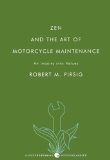  |
Deadeye Dick: A Novel by Kurt Connegut I have thoroughly enjoyed every Vonnegut book I have picked up thus far, and Deadeye Dick did not disappoint. I enjoy Vonnegut’s pacing, sense of humor, and overall style. In true Vonnegut style, around 50 pages in he tells you how the book is going to end...I always may know the destination, but I never know how he is going to take me there.
If you are also working your way through Vonnegut’s collective works do not skip past Deadeye Dick. I have thoroughly enjoyed every Vonnegut book I have picked up thus far, and Deadeye Dick did not disappoint. I enjoy Vonnegut’s pacing, sense of humor, and overall style. In true Vonnegut style, around 50 pages in he tells you how the book is going to end...I always may know the destination, but I never know how he is going to take me there.
If you are also working your way through Vonnegut’s collective works do not skip past Deadeye Dick. |
  |
Rigged: The True Story of an Ivy League Kid Who Changed the World of Oil, from Wall Street to Dubai by Ben MezrichI have a thing with people named ‘Ben’...I’m sure its mostly me and not them, but I have a thing.
I have yet to met another person named 'Ben' that I liked.
It begs to be asked, if I ran into myself would I like me?
Think about the recursive loop that little meeting could spin into...
Or, or pickup Rigged by Ben Mezrich. This Ben might be one of the few I might enjoy if I were to ever meet him in real life.
You may or may not know Mezrich from his more widely known book 21: Bringing Down the House - Movie Tie-In: The Inside Story of Six M.I.T. Students Who Took Vegas for Millions by Ben MezrichI have a thing with people named ‘Ben’...I’m sure its mostly me and not them, but I have a thing.
I have yet to met another person named 'Ben' that I liked.
It begs to be asked, if I ran into myself would I like me?
Think about the recursive loop that little meeting could spin into...
Or, or pickup Rigged by Ben Mezrich. This Ben might be one of the few I might enjoy if I were to ever meet him in real life.
You may or may not know Mezrich from his more widely known book 21: Bringing Down the House - Movie Tie-In: The Inside Story of Six M.I.T. Students Who Took Vegas for Millions .
::...if you haven’t had the chance to enjoy Bringing Down the House, Mezrich’s first widely known outing, skip the movie they based off his book and grab yourself an excellent Vegas thriller.::
Mezrich brings his signature storytelling style to his latest outing. Mezrich starts with an Ivy league grad seeking direction in his life and places him in the middle of dark underground world full of colorful people and larger than life events.
When I pickup a Mezrich book by this point I know the formula, I just don’t know what he will plug in for characters, locations, and main ‘event’. In Rigged we start with a recent Harvard Business School graduate, graduating into one of the worst job market for MBAs, the fall 2002. Take said graduate and introduce him to a powerful person, head of the NYMEX, inject a little oil trading, and let the fun commence!
Its not a bad formula...I’ve grown to enjoy it. .
::...if you haven’t had the chance to enjoy Bringing Down the House, Mezrich’s first widely known outing, skip the movie they based off his book and grab yourself an excellent Vegas thriller.::
Mezrich brings his signature storytelling style to his latest outing. Mezrich starts with an Ivy league grad seeking direction in his life and places him in the middle of dark underground world full of colorful people and larger than life events.
When I pickup a Mezrich book by this point I know the formula, I just don’t know what he will plug in for characters, locations, and main ‘event’. In Rigged we start with a recent Harvard Business School graduate, graduating into one of the worst job market for MBAs, the fall 2002. Take said graduate and introduce him to a powerful person, head of the NYMEX, inject a little oil trading, and let the fun commence!
Its not a bad formula...I’ve grown to enjoy it. |
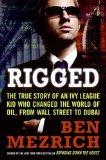  |
19 Nov 2009
Lately I’ve been pondering, “Why is it that most people design the user interface last?”
It would seem, to me at least, if one were to design a product for the mass market, one would focus a lot of time and energy on how that product would be seen by that market. What will it look like, how will it function in peoples’ hands, how will people interact with it.
Seems logical, if you want people to like your product they need to enjoy using it. Spend a lot of time making that product enjoyable to use and people will love you. If on the other hand, you make using your product painful, awkward, and hard people will tend to shy away from using your wares, and you can bet they will tell their friends about their horrible experience.
I was inspired for this posting on a recent trip to San Diego where we rented a nice economy car for the trip. I snapped a few pictures of the car’s “user interface,” or inside, to share with you some of the pain I experienced on our trip.
I give you, auto fail.
Figure 1, the steering wheel from our rental car.

Figure 1. Steering Wheel on Our Rental Car
Seems to hold the function of most steering wheels, its round, it was fairly comfortable, as so much it wasn’t wrapped in barbed wire, and when I turned the steering wheel the car also turned…so far so good.
Let’s take a closer look at the two controls they deemed necessary to include on the left hand side of the steering wheel.
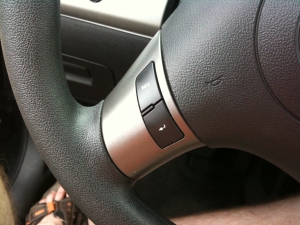
Figure 2. Up-close and Personal With the Steering Wheel
Two buttons are included in Figure 2, they must be important, right? I mean someone took the time to make a mold of the steering wheel and cut out those two buttons, then run wire all the way up the steering column to connect to these two very important buttons.
These two buttons control:
- The information that is displayed on the dash, mpg, average speed, distance to empty.
- A return button. Honestly, I’m not sure what it actually returned from.
In most every car I have ever driven these buttons are replaced by a stalk that comes out of the dashboard, or they are on the end of the turn signal. They are never given prominence of being placed on the steering wheel where so many more important buttons could go, like radio controls, cruise control, anything that could actually help me while I was driving!
And what type of great information did these two buttons deliver?

Figure 3. Information Display on the Dash
You get the coolant temperature…
What am I going to do with the coolant temperature? Is it going to change the way I am driving? Should I shut off the AC? Should I change a tire? I have no idea what this piece of information on my dash serves me as I drive.
So far I have two buttons on this car that take up some prominent car real-estate, strike one. On top of that these buttons show me information I can’t even do anything with, strike two.
Strike three comes in the form of the emergency brake.

Figure 4. The Emergency Brake
At first blush the emergency brake looks perfectly functional. Figure 4 was taken with the armrest up. Figure 5 is how the emergency brake is normally in the car.

Figure 5. Normal View of the Emergency Brake.
The emergency brake is completely covered by the armrest. Every time I park I need to lift the arm rest to use the emergency brake. Every time I want to start driving again I have to lower the arm rest to make it functional. A fairly simple task, parking and then driving, complicated by constantly having to raise and then lower the arm rest to get to the piece of equipment I want to use.
If I owned this car it would drive me insane, (no pun intended), every time I went to use the car.
Needless to say I had a horrible experience driving this car and I’ve now told all my friends about it.
17 Nov 2009
“Breaking Down the Game Film” is a term commonly used to analyze tape from an already played sports game to dissect what went right and what went wrong. In this series I’ll be taking published articles from around the web and break them down.
Topic: Micro Code Reviews
Article: “The Joy of Code Reviews”
Author: Tom Hollander
Link: http://blogs.msdn.com/tomholl/archive/2009/01/06/the-joy-of-code-reviews.aspx
Short Summary: Full code reviews are done too infrequently, and take too much time to complete to be done with any real regularity. Micro code reviews, performed before every check-in, provide you and your project all the benefits of a full fledged code review, but also facilitate knowledge transfer between team members, an avenue to provide mentoring, and a chance for your team to “show off” to one another that cool new algorithm they have been working on. All in 15 minutes or less!
Analysis:
When was the last time you reviewed the whole codebase for your project? Stem to stern? I know, I know, who has the time. Everyday the codebase gets larger and larger, and each one of your team members becomes more and more specialized in whatever it is they are working on day in and day out. What happens if one day George walks in and goes, “I’m off to Alaska to follow my one true calling. Being a software developer is nice and all but I wanted to be… a lumberjack!”
::Deep down you know he’s a lumberjack, and he’s ok. He likely will sleep all night and work all day, but I digress…::
George is gone. When was the last time anyone was looking at his code? Who on your team knows how his really cool, yet very complex, algorithm runs? Sure it all works, but who last put eyes on his code to try to and understand it?
If I know your team, and I likely don’t, but I’ll assume I know them, no one has looked at his work in a while. Why would they? George’s code worked, all of his tests passed, who has the time to review working code?
Your project has just suffered a major brain drain, and you don’t have a plan on how to recover quickly.
Tom’s article, “The Joy of Code Reviews”, provides some great reasons for you and your team to adopt what I’ll call micro code reviews. A micro code review works like this:
- Before every check-in to source control George grabs a fellow team member, Stan, and they review all the changes that are about to be committed to source control.
- In Tom’s article he states these reviews often last 15 minutes, some much shorter, some a little longer. Fifteen minutes seems just about right for a couple of programmers to review a bug fix or feature enhancement and has been the typical amount of time my team and I have taken for our own micro code reviews.
- After George and Stan have reviewed the code, ensured the unit tests pass, and then check the code into source control.
Pretty simple and straight forward; spend 15 minutes before every check-in, or 30 minutes billed to your whole project, to get a second set of eyes on the code that is getting into your source tree. On top of that:
- In his article Tom calls out one of the great benefits in doing these reviews is the mentoring that can take place between two developers. George has a chance to show Stan the new functionality he has implemented and possibly a new way to write code, debug, or write tests. As Stan is exposed to George’s style he may pick up a tip or trick just watching him work.
- I’ve personally seen George improve his ability to explain complex thoughts and algorithms to Stan. Oftentimes we work in isolation, only explaining things to ourselves. By sharing with Stan and forcing himself to verbally explain things George has a chance to work on his presentation skills as he breaks down a complex problem to Stan.
- Micro code reviews provide a chance for a team to feel more like a team as they work directly with one another. I feel my team has gelled together a little more with these mini interactions that take place during these micro code reviews.
- One might think developers would be resistant to these micro code reviews, however I found when I argued one could “show off” that cool new thing they did everyone seemed to get on board after doing a few code reviews. Software developers love to have the admiration of their peers, give them a stage and most of them will step up and gladly perform.
I’ve adopted micro code reviews for my team and have had some excellent results. Team members are grabbing one another when before new code is committed to the system. Spirited debate takes place between the developers while reviewing the code, and learning is going on as each one learns from one another. For us it has been a huge win win.
So when George answers his primal calling to be a lumberjack…
:: He cuts down trees.
He eats his lunch.
He goes to the lavatory.
On Wednesdays he goes shopping
And has buttered scones for tea.
I’m done, I’m done, I swear. No more Monty Python for this post…::
You and your project will be prepared.










